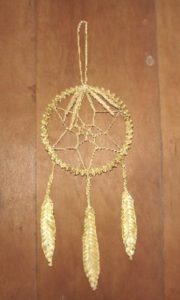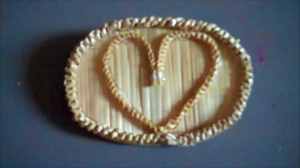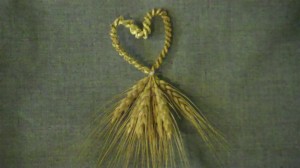The Origins of Wheat Weaving
One of the more beautiful crafts still practiced today, the origins of wheat weaving go back thousands of years.
Also known as corn dollies in some places, wheat weaving was commonly found in many ancient civilizations. But the majority of the traditional designs we still have today came from the Celtic European farm lands. In those days, when everyone’s lives depended on a bountiful harvest, there were many superstitions that abounded. Certain practices were believed to ensure a good crop for the year. Wheat weaving was one of those practices believe to bring a lucky harvest.
Capturing the Spirits of the Grain
 At the end of a good harvest season, farmers would gather the last few remaining stalks of wheat. They would then weave the stalks into intricate designs. They believed that doing so would capture the benevolent spirits of the grain that made a good harvest possible.
At the end of a good harvest season, farmers would gather the last few remaining stalks of wheat. They would then weave the stalks into intricate designs. They believed that doing so would capture the benevolent spirits of the grain that made a good harvest possible.
These wheat weavings were kept inside all winter. When spring arrived, the designs were unwoven and the wheat heads were the first seeds that were sown for that year’s crop. The idea being that the lucky spirit was still in the wheat and would ensure a bountiful harvest.
Wheat Weaving For Love
Wheat weavings were also used as courting favors. This is why so many traditional designs feature hearts or “love knots.” A man who wanted to impress a lady, would pluck a few wheat straws and weave a brooch or something similar. If the lady chose to wear it, it meant she had accepted, and the two were then courting.
While the superstitions associated with this ancient art have passed, these designs are every bit as beautiful today as they were thousands of years ago. As such, we still weave them for aesthetic pleasure. They can also be woven from many other types of grain as well. It needn’t be just wheat. You can use oats, or barley, or wheat, or rye, or even a mixture of the different grains. It makes for interesting designs when you mix textures.
 Personally I’m partial to rye. For one thing, I grow it on my farm, because it’s good for the soil. As such I always have a lot of rye in abundance here. Another reason I love rye is because the straws are longer than most other grains, so I don’t have to replace them as often. Experiment with different types to see what kind you like best.
Personally I’m partial to rye. For one thing, I grow it on my farm, because it’s good for the soil. As such I always have a lot of rye in abundance here. Another reason I love rye is because the straws are longer than most other grains, so I don’t have to replace them as often. Experiment with different types to see what kind you like best.
A Little Inspiration
If you need a little inspiration, check out my wheat weaving tutorials here.
And even though wheat weaving hasn’t been used for courting in centuries, there’s no reason to think it won’t work just as well today. Let’s face it, if a guy is gonna weave a heart out of wheat to get a lady’s attention, he’s probably a keeper 
Written by Amber Reifsteck, The Woodland Elf
The information provided on this website is for general information purposes only. If you choose to rely on the information on this website, you do so at your own risk and you assume responsibility for the results. (Full disclaimer here)
Enjoy this post? Click here to subscribe by email and get new posts delivered to your inbox.Ads by Google










Hello Woodland Elf:
I each wheat weaving at the Jersey shore in the US. I’ve been looking for the history of wheat weaving and am wondering if you have any history sources for me to check out.
There’s a great book called The Book of Wheat Weaving and Straw Craft you should check out. The author delves into a lot of the history in that as I recall. (And the weavings in the book are quite beautiful too!)
I am a newbe to wheat weaving thanks to your videos – love it. But I have a problem. My house is full of moths from tge wheat!! Is this normal and should I be worried? Would appreciate your reply. Thanks.
I haven’t run into that problem, but you could try putting a little lavender or peppermint oil in the water when you soak your wheat to weave it as those are moth repellents. And keep any unused wheat in a sealed plastic container that the moths can’t get into. (Just make sure the wheat is fully dry when you put it in the container so it doesn’t mold).